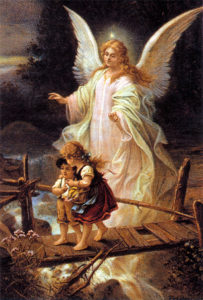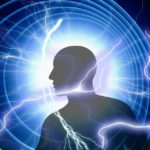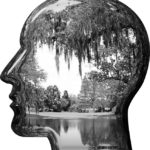Our Inheritance of Light
By Jeva Singh-Anand
Know, O man, that Light is thine heritage.
Know that darkness is only a veil.
Sealed in thine heart is brightness eternal,
waiting the moment of freedom to conquer,
waiting to rend the veil of the night.
– From The Emerald Tablets of Thoth
How is it that discussions of a sacred vocation such as Magick can never disentangle themselves from those distractions Magick seeks to transcend? Those mindless wranglings about the terrors of the Abyss that bring destruction and madness to those who step where they should not, the senseless arguments about what distinguishes the right-hand path from the left-hand path, and those much too lofty promises that Magick will solve all problems are found not only among neophytes and those simply too ignorant to investigate the matter beyond what they have learned from the Hammer Studios horror flicks. They also abound in the loftier circles of those who have studied Magick and who, consequently should know better. Magick is a spiritual practice that raises the consciousness of the practitioner to an awareness of a reality greater than the physical. Attaining to such awareness does indeed have its dangers, because every time our experiential horizon expands, we are forced to reassess, and often abandon, those perceptions of the universe and ourselves that have defined us. That also includes moral and ethical values we may have cherished. Solomonic, Thelemic and other magickal traditions ensure that our progress occurs at a steady, but measured pace, however. That is a task that is neither fast nor easy.
The most vicious and useless discussions involve attempts to distinguish “black” magick from “white” magick, the “right-hand path” from the “left-hand path.” Don Kraig, in Modern Magic, has pointed out that the techniques of “black” and “white” magicians are pretty much identical, and Arthur E. Waite, in The Book of Ceremonial Magic, dismissed all aspects of Solomonic Magic, as black and evil. This, of course, is in stark contrast to the assertions of Eliphas Levi and others, who proclaim it as a Holy science. It is ironic that many would-be magicians take such claims at their face value, without considering the larger context or the agendas of their authors, and promptly choose camps.
If the work of the magician is good and Holy, why does he consort with infernal powers? If the initiate to a magickal order such as The Golden Dawn is to “flee the darkness and seek the light,” exactly what would possess her to play with demons and assume the right to boss around the angels of the Heavenly spheres? It is a paradox that confounds the wise and a mystery that frustrates the brave, causing Eliphas Levi’s hair to turn grey, making Aleister Crowley tear at his dark tresses until he was completely bald.
Levi’s struggle to explain this mystery in Dogma and Ritual of High Magic is heroic, and his etching titled “Per Benedictionen YHVH Maledictus YHVH Adumbratur,” in which a hand making the Sign of Benediction casts the image of the devil onto a wall has been used by a number of authors on the occult, including Aleister Crowley, to illuminate it.
“The Lucifer of the Kabbalah is not an evil and accursed angel; he is the angel who illuminates and renews through conflagration,” He wrote. The destruction and apparent evil he creates serves to teach, to create insights, and to make room for new growth.
Levi compared Lucifer to a fiery comet, who shocks and frightened his celestial brothers, the fixed stars, with his absurd and erratic path. Replying to their pleas to join them and to cease disrupting the tranquility of the Heavens, Levi’s Lucifer says,
Do not believe, thou my Brother, that my adventuring can disturb the Harmony of the Spheres. As unto thee, so has God set my own path before me, and if my orbit appeareth unsure and erratic to thee, it is only because thine rays are not sufficient to encompass the ellipsis that is mine predetermined path.
To Levi, magick offered a model that allowed for a scientific approach to religion in Napoleon’s hyper nationalistic, post-revolutionary France, and he can be considered a forefather of the scientific illuminism pioneered by Crowley and further developed by Robert Anton Wilson. In other words, magick, to Levi was a bridge between religion and science.
Levi, who like Crowley possessed a wonderful sense of humor, never fully abandoned the morality and dogma of the Roman Catholic Church, and Legend has it that he reconciled with the Church and was administered Last Rites on his deathbed. Crowley’s religious upbringing by the Plymouth Brethren can only be described as abusive, even by the most forgiving standards; he had no qualms about examining magick without the blinders of Christian morality, or, for that matter, the moral standards of any religion.
Like science, magick was to be practiced in the absence of moral or ethical baggage, Crowley argued. Hence the motto of the A:.A:., “We place no reliance on virgin or pigeon. Our method is science, our aim is religion.”
After all, chemical sulfur is no more or less morally pure than chemical platinum, and gravity is no more or less noble than electricity.
In Magick Without Tears, Crowley outlined three schools of magickal thought, the Black School, the White School, and the Yellow School. The Black School considers existence as a curse, filled with sorrow, from which redemption must be sought. The White School, on the other hand, considers existence in all its aspects as joyful. But the Yellow School stands aloof of both Schools, viewing existence and the universe as neither good nor evil, neither joyous nor sorrowful, only factual.
In light of this view, the practice of magick assumes a dimension that has nothing to do with traditional, unreliable ideas of good and evil. Magick rises above such vague notions, which I will discuss at a later point in this article. Crowley’s magick is utilitarian, functional.
It is particularly to be noted that Magick, so often mixed up in the popular idea of religion, has nothing to do with it; it is, even more than Physical Science, its irreconcilable enemy. … Magick investigates the laws of Nature with the idea of making use of them. … Religion, on the contrary, seeks to ignore the laws of Nature or to escape them by appeal to a postulated power which is assumed to have laid them down.
Yet magick is undoubtedly a spiritual practice, a practice that allows the magician to commune with the divine, channeling it at the same time into the mundane world. That is the purpose of magick. Rabbi Aryeh Kaplan explained that, according to the Zohar, the purpose of humankind is to bring light into the darkness. To assume that the divine is good or evil by the standards of any human moral code, however, is cynical. And to draw any moral guidance from religious scripture is desperate.
In Genesis XXII, God tells Abraham to kill Isaac, but halfway through the chapter, He changes His mind. The city of Sodom is destroyed in Genesis XIII because of the moral corruption of its citizens, yet at the end of the chapter the sole survivors, spared for their virtuousness, commit incest. What is remarkable about this particular case is that Lot is raped by his own daughters. The city if Niniveh is spared, but YHVH smites an innocent tree to teach Noah a lesson about compassion. The New Testament isn’t much more consistent when it comes to offering moral guidance. Jesus says he has come to uphold the law, not to discard it, yet he harvests on the Sabbath and saves the life of the adulteress who by law should have been put to death. Is it any wonder that Shakespeare remarked, “The devil can cite scripture for his purpose?”
For brevity’s sake, I will refrain from pointing out similar contradictions that can be found in other faiths, but it is reasonable to suggest Christianity is no more riddled with contradiction than any other religion, be it Hinduism, Islam, Buddhism, or Wicca. All claim to be “good,” and their commandments and instructions are often at odds with those of others. Eat pork, don’t eat pork. Have one wife, have four, have many. The Sabbath is Sunday. No, Saturday. No, Friday. Consort with angels, but stay away from the occult. Yet all religious texts also have buried within them gems of lucidity. Moses kneels by the Burning Bush and asks who is appearing to him. He receives the cryptic answer, “AHIH AShR AHIH.” That roughly translates to, “Being is.”
 In his Eight Lectures on Yoga, Crowley discussed the function of the concepts of Yama and Nyama, the twenty dos and don’ts of Hinduism. He pointed out that many faiths and spiritual disciplines have their own versions of them, explaining that their primary purpose is simply to train the Will. Others assert that the Ten Commandments and the ten lines of the Lord’s Prayer correspond to the ten Sefiroth on the Treet of Life. Rabbi Kaplan’s theory concerning Sefer Yetzirah is especially interesting. He noted that in Hebrew, the third person singular and the imperative are identical. If Sefer Yetzirah is written in the imperative, it is not merely an account of the Universe’s creation, but it becomes an instructional manual on meditative techniques.
In his Eight Lectures on Yoga, Crowley discussed the function of the concepts of Yama and Nyama, the twenty dos and don’ts of Hinduism. He pointed out that many faiths and spiritual disciplines have their own versions of them, explaining that their primary purpose is simply to train the Will. Others assert that the Ten Commandments and the ten lines of the Lord’s Prayer correspond to the ten Sefiroth on the Treet of Life. Rabbi Kaplan’s theory concerning Sefer Yetzirah is especially interesting. He noted that in Hebrew, the third person singular and the imperative are identical. If Sefer Yetzirah is written in the imperative, it is not merely an account of the Universe’s creation, but it becomes an instructional manual on meditative techniques.
The problem with Old-Aeon conceptions of good and evil is not their dychotomous nature, the idea that Universe is divided into moral or ethical opposites. It lies in two human misconceptions: that good and evil are constants, and that the Deity is benevolent as defined by specific cultural standards. In other words, Old-Aeon thinking claims that Divine favor can only be attained by adhering to the standards of one specific religion. Hence such thinking not only fails to offer any satisfactory explanation of why an omnipotent, benevolent Deity would permit the existence of evil. It also gives birth to religious fundamentalism, the cause of stupidity and cruelty whose effects are far more devastating than the Jihads, Crusades, and Holocausts they have created.
“The most terrible magickal poisons,” quipped Levi, “are the mystic excesses of falsely understood piety.”
“Praise Jesus!” cry the right-hand path walkers, “Hate Satan! Kill the Heathens!”
And from the left-hand path comes the response, “Hail Satan! Jesus is dead! Kill the weak!”
Levi’s definition of evil did not hinge on particular symbols, such as the horned Baphomet or the inverted cross or pentagram. To Levi, evil constituted a pathological kind of irrationality, and his commentaries of black magick and demonic pacts illustrate this very clearly,
The devil will appear and show himself to those who invoke him with the proper ceremonies. And they who do not at his sight, drop-dead as if struck by lightning or at least are beset by cramps or insanity, are already insane.
As a prerequisite to such ceremonies, wrote Levi, the practitioner needed to possess: an unconquerable sense of prejudice, a complete absence of conscience, total natural or artificially induced ignorance, blind faith in the incredible, and “a completely false image of God.”
Religious and occult imagery nearly always misleads the aspirant. Papus and others remind us that there are four distinct ways of interpreting Scripture, expressed in the formula PRDS, the Hebrew word pardes, which in its Anglicized form becomes “Paradise.” As all such formulae, PRDS is an acronym. It stands for Pashut, Remmez, Derash, Sod. Pashut is rote memorization. Remmez is the understanding gained by allegory and inference. Derash is knowledge given under the seal of secrecy. And Sod is knowledge received by divine intuition. One must follow the other.
Dan Brown, drawing from the speculations of others, has spun a fine yarn in The DaVinci Code, but I must confess that I find the theories regarding hidden Goddess symbols and vitriolic commentary on the Church entertaining, but not particularly convincing. The “hidden” Vs and Ms in “The Last Supper,” allegedly representing the Goddess and the marriage of Jesus and Mary Magdalene, are sloppily drawn, and honestly, it takes a lot of imagination to notice them.
Masaccio’s painting “The Holy Trinity,” on the other hand, yields a veritable treasure trove of occult symbolism, in plain sight to those who know what to look for. What at first glance may appear to be a brilliantly painted, but typically depressing, crucifixion, complete with martyrs, penitents and divine bearded father, becomes after closer investigation a powerful allegory of the Great Work.
It is interesting to note, that the crucifixion is shown in an indoors location, not as traditionally done, outdoors, giving the painting a decidedly staged, ritualized character. That, however, is not by far the most telling sign. Drawing connecting lines from Christ’s hands to the foot of the cross and connecting lines from the eyes of the penitents to each other and to the hands of Christ, a perfectly drawn inverted pentagram is revealed. Looking at key points in the arch framing the scene, we can clearly see the Sefirot of the Tree of life. Christ hangs from a Tau-Cross, not the four-armed crucifix we know from similar paintings. A complete discussion of the kabbalistic and alchemical symbolism in the painting would be the subject of a separate article. Suffice it to say: armed even with this introductory knowledge, a meditation on “The Holy Trinity” will prove rewarding, yielding more gnostic symbolism than Church fathers would like to admit.
Symbols do not reveal themselves to those who have not learned their mysteries. The fact that conventional wisdom about commonly known symbols, such as the Pentagram, Levi’s Goat of Mendez, or Crowley’s Satan, is not only dead wrong but further charged with so much negative emotional baggage confuses matters to a point that lies hopelessly beyond hopelessness. Stephen A. Dafoe has explained that the symbolism of the Pentagram has changed throughout history. At one point it was even adopted by the Christian Church. Levi’s Goat of Mendez is not an entity, but a symbolic depiction of the condition of man and the universe. And Crowley’s Satan has very little to do with devil worship; rather, it is the awareness that destroys the idea that man-made religious dogma can bring humanity closer to the Divine.
“I am in a secret fourfold word, the blasphemy against all gods of men,” declares Horus in the Book of the Law.”
Crowley elaborated,
The evident interpretation of this is to take the word to be “Do what thou wilt,” which is a secret word because its meaning for every man is its own inmost secret. And it is the most profound blasphemy against all “gods of men”, because it makes every man his own God.
In truth, this is merely a militant expression of the deceitfully cozy “Namaste The God within Me acknowledges the God within Thee,” which is so thoughtlessly exchanged in New Age circles.
The encounter with the Divine and the realization that human beings are not only worthy and holy but divine is neither docile nor reassuring. In fact, it is positively terrifying. Divine revelations often involve visions of global destruction and mass-scale suffering; they teach by hyperbole, exaggeration. Encounters with divine beings are often brutal. They are experienced as vicious assaults, such as The Ecstasy of St. Teresa, pierced by angelic arrows through the heart, and the Conversion of St. Paul, who was struck blind on the road to Damascus. This sort of cruelty is not limited to Christian legend. We find it among the Ancients, as well. Zeus, in the shape of a Swan and a Bull, rapes Leda and Europa. Poseidon kidnaps Ariadne, the lover of Theseus. And Daphne so fears the physical encounter with Apollo that she begs her father to transform her into a tree.
Direct encounters with the Divine are not necessary to strike fear into the hearts of the careless.
Knowing that such a thing is possible will often do the trick. Just how terrifying, truly, is it to participate in the Communion of the Gnostic Mass: to invoke the essence of the light of the sun and the joy of the earth, to face the assembled, and to declare, “There is no part of me that is not of the Gods?” Yet I have seen people run from the Lodge when it was their turn to do just that.
 The ancient Greeks warned that a mortal who would behold a God in His true form would burn to ashes by the Divine Brilliance, and Zeus’s wife Hera used that trick more than once to eliminate her husband’s mortal lovers, the most famous of whom was Alcmene, mother of Herakles. And not only horror-fiction writers, but actual occult scholars caution that only those who are worthy, that is: ready for such work, should embark on spiritual quests involving the study of the Kabbalah or begin to work with the Goetia. They warn of destruction and madness, and considering the effectiveness of Kabbalistic formulae and Goetic workings, these warnings are not baseless.
The ancient Greeks warned that a mortal who would behold a God in His true form would burn to ashes by the Divine Brilliance, and Zeus’s wife Hera used that trick more than once to eliminate her husband’s mortal lovers, the most famous of whom was Alcmene, mother of Herakles. And not only horror-fiction writers, but actual occult scholars caution that only those who are worthy, that is: ready for such work, should embark on spiritual quests involving the study of the Kabbalah or begin to work with the Goetia. They warn of destruction and madness, and considering the effectiveness of Kabbalistic formulae and Goetic workings, these warnings are not baseless.
A person who is afraid to declare her own divine nature before a group of Thelemites has no business becoming the living center of the holy mandala which is the Goetic circle. The task of the magician is to first build the entire universe in her own consciousness before she can hope to manipulate its fragments: its elemental spirits, its demons, and angels. Levi cautioned,
They who fear water shall never rule Undines; they who fear fire shall never command Salamaders; they who fear heights must leave Sylphs and Gnomes undisturbed; because these spirits obey only a power that has proven itself a master in their realm.
Equilibrium must be attained first.
Else one is certain being overcome by one’s own demons. Only a person who has managed to reconcile the universe withing herself can hope to emerge from the trials which the path of Spirit exacts without being destroyed emotionally or physically.
No path on the Tree of Life leading from the Man of Earth Triad, the Sefirot from Yesud to Netzach, can be described as pleasant. Yesud, Hod, and Netzach define the olam-ha Yetzirah, the realm of the astral, which as occult scholars warn us “seeks to deceive.” The mere synthesis of our astral awareness is traumatic, as the path Peh, which connects Hod, our highest intellectual awareness, and Netzach, our highest intuitive awareness, demonstrates. The Tarot Trump representing this path is one of the most frightful images in the entire deck: The Tower.
The task of raising one’s consciousness above the world of Yetzirah to attain to Tiferet, our Solar Consciousness or Higher Self, is much more daunting. To attain to Tiferet from Hod, one must travel the path Ayin, the Devil. From Netzach, one must pass the ordeal of Nun, Death. And traveling from Yesud, the trials of Samekh, The Tempering, are exacted of the magician.
The trial of Ayin, The Devil, requires complete acceptance of the fact that while the spirit may be eternal, material existence is not. Nothing we own, do, experience, remember, know, or believe is possessed of any permanence whatsoever. The only existence is many wise books have been written on the futility of materialism and the evils of what has been called attachment. The irony is that those who accept these teachings often treasure them as well. The wisdom that love of possession is useless becomes itself a prize possession of the mind. The realization that not even this gem of wisdom may be carried beyond the veil of death is terrifying. He who can achieve peace with it, passes the trial.
New Age Fair fortune-tellers try to assuage their terrified clients when Atu XIII, the Death card, appears in a reading. It doesn’t signify actual death, they promise, only change. The truth is that most people fear change far more than they fear death. Otherwise, no one would smoke or eat factory-raised meat, and everyone would recycle and walk rather than drive whenever possible. There would be no wars to defend anyone’s way of life, American or Christian. It would be much kinder of these card readers to tell their clients that they are indeed about to die and that they had better begin making their lives meaningful before it is too late.
The path Nun, the thirteenth Tarot Trump, does indeed indicate death, and if not imminent bodily death, it focuses our attention without mercy or compassion to its inevitability. It is impossible to reach the infinite without relinquishing the limitations of our consciousness. That sounds much more pleasant than it really is, and many enlightening books have been written on this topic, as well. The problem is that our identity is defined by our limitations: bodily, emotionally, sexually, intellectually, and spiritually. We are who we are because we are not someone else: male or female, gay or straight, bipolar or ADD, right-brained or left-brained, enlightened or pentecostal. When we die, we cease to be any of these, or we become all of these. The infinite and the infinitesimal both lie outside our perception or understanding. There is no guarantee the Buddha will not smoke crack in His next incarnation, no matter what the Buddhist tells us. Therefore, praising God will bring us no closer to salvation than blaspheming Him will earn us eternal damnation, so it is really best not to talk about Him, at all. Naturally, experiencing physical death to attain to the Higher Self, renders the Hermetic Kabbalah useless for any practical purposes, especially magick. Mystery traditions, therefore, incorporate symbolic death and rebirth experiences into their initiatory ceremonies. While they may not necessarily be lethal, they leave profound and long-lasting effects on the candidate’s psyche.
 The image of the smiling Holy Guardian Angel pouring the astral light from one chalice into another in the Trump called Temperance (which really ought to named Tempering, as in the tempering of steel, Melita Denning and Osborne Philips point out) is misleadingly tranquil. The aspirant walking the path Samekh is well-advised to have within him all conflicts reconciled. The journey begins in Yesud, the Lunar consciousness and the most rudimentary awareness of an existence beyond the material realm of Malkut, bringing the magician face to face with the Solar consciousness, Tiferet. This occurs at breakneck speed; the magician traveling this path is like an arrow shot from a bow. While this experience can take place under controlled circumstances and of one’s own volition, during a kabbalistic pathworking, for instance, the better-known examples involve the Higher Self dragging the individual by the scruff of the neck out of his ordinary awareness. These are the apocalyptic visions and rapes by deity experienced by mystics throughout history. They are experiences that traumatize the individual, violate his humanity to the very core, very much like a mighty storm causing the levies to break and cities to be deluged. The encounter with the divine is never pleasant, never gentle, because it beckons us to face that which is infinite and challenges us to abandon that which limits us. But what limits us is nothing less than our own sense of self.
The image of the smiling Holy Guardian Angel pouring the astral light from one chalice into another in the Trump called Temperance (which really ought to named Tempering, as in the tempering of steel, Melita Denning and Osborne Philips point out) is misleadingly tranquil. The aspirant walking the path Samekh is well-advised to have within him all conflicts reconciled. The journey begins in Yesud, the Lunar consciousness and the most rudimentary awareness of an existence beyond the material realm of Malkut, bringing the magician face to face with the Solar consciousness, Tiferet. This occurs at breakneck speed; the magician traveling this path is like an arrow shot from a bow. While this experience can take place under controlled circumstances and of one’s own volition, during a kabbalistic pathworking, for instance, the better-known examples involve the Higher Self dragging the individual by the scruff of the neck out of his ordinary awareness. These are the apocalyptic visions and rapes by deity experienced by mystics throughout history. They are experiences that traumatize the individual, violate his humanity to the very core, very much like a mighty storm causing the levies to break and cities to be deluged. The encounter with the divine is never pleasant, never gentle, because it beckons us to face that which is infinite and challenges us to abandon that which limits us. But what limits us is nothing less than our own sense of self.
What characterizes magicians is that they actively engage in practices that expand their experiential horizon. For the magician, it is not enough to simply read the ancient grimoires and to study the meaning of myths. The magician engages in physical rituals that bring him face to face with the divine at a measured pace.
The full awareness that our material existence is only a small aspect of a very wide spectrum of states of being is so overwhelming that it necessarily traumatic. The whole purpose of magick and mysticism is to prepare the individual for the encounter with the infinite. Out of the various religious systems he studied, Crowley initially felt that Buddhism was the most practical because Buddhism outlined the entire process of attaining illumination, the full awareness of the infinity of the divine, more clearly than Christianity, Islam, and Hinduism. Solomonic Magick and Crowley’s revision of it are just as practical, and while Buddhism represents what Crowley termed “The Black School” because existence is considered sorrowful. Not so with magick.
Magick, however, is not the quick and easy way to health, wealth, sex, and enlightenment everyone would like it to be. Not because it doesn’t work or it is a psychological exercise to motivate the practitioner to do the things necessary to obtain the desired results. Magickal work requires continued effort and self-discipline. It is slow, plodding, and often tedious work. Those who expect dramatic results of any sort in the first few weeks, months, or years are often bitterly disappointed.
The slow nature of such work, which exacts disciplined study and continued effort without the expectation of immediate physical results is Magick’s most powerful safeguard. When done correctly, magickal workings will allow the practitioner’s psyche to expand its experience horizon only at a pace it can safely absorb. The much too eager student may proclaim he is ready for enlightenment, the direct and unadulterated contact with his higher self, because he is surely self-balanced, rejects materialism, and laughs at death. Let St. Teresa’s angel stab him through the heart with arrows, let him experience the mortal terror of battle, and let him find himself destitute and friendless. He will find out just how ready he was for any of it. And what of the direct encounter with the noncorporeal world? How can a person terrified of the horrors ascribed to the Ouija Board expect to not only face but command a Goetic Demon? Abramelin is supposed to have said that a magician should prepare himself for at least six years before attempting such work. Truly, that is spiritual advancement at break-neck speed.
Human beings are indeed capable of controlling angelic beings because humans are microcosmic and angelic beings are limited to certain spheres of existence. In other words, humans have within themselves the totality of the universe, while angels, demons, and elementals do not. Our physical existence, life experiences, and social environment have taught us that the opposite is true, however.
Preliminary work is so very important
This is why the preliminary work is so very important. The magician’s first task is to rebuild within her the awareness that she is a divine being, unique and beautiful, that she has been placed into this world with a specific purpose only she can fulfill. Those who lack this awareness and successfully establish contact with fragmentary beings find themselves at the mercy of their whims.
Preliminary works, such as the Lesser Banishing Ritual of the Pentagram, The Middle Pillar Exercise, The Banishing Ritual of the Hexagram, and the Invocation of the Bornless One, are designed to raise and strengthen the magician’s awareness and psyche, so that at length they will be able to control those fragmentary beings who exist outside ordinary consciousness. They may even make it possible for him to face his own divine reality without being burned to cinders.
These exercises must be studied and practiced regularly.
Israel Regardie suggested that those who embark on the path of Magick practice the LBRP and the Middle Pillar Exercise on a daily basis for at least a year. These are simple, yet beautiful and powerful ceremonies of self-transformation, and the practitioner should not be put off by their Judaeo-Christian roots; the discipline of banishing the distractions of our day-to-day awareness so that we may open within ourselves the path to our own divine source and the act of circulating the divine light through our physical bodies are practices that transcend religious doctrine.
The practice must be combined with the study.
To simply parrot the LBRP or the Goetic Invocations without a thorough understanding of these rites is to engage in superstition; it has nothing to do with magick, and they who do so it are fortunate, if their efforts bring no results whatsoever. Those who know no other practice than the Kabbalistic Cross, yet have a sound understanding of it, are greater magicians than those who can recite in the correct order the Barbarous Names of the Bornless Rite, yet do not even know from which culture they are derived.
Crowley reminded us that every conscious act can be considered an act of Magickiii. To attain full consciousness of who we are, we must develop an awareness of where our boundaries lie, physically, emotionally, intellectually, and so forth. The further we can expand these boundaries, even to the point of dissolution, the more effective our Magick becomes. But this must occur at a pace our psyches can safely absorb.






